Meal planning apps are a matter of the day that has transformed our health and lifestyle.
Post-pandemic people’s interest in maintaining their well-being and living a healthy lifestyle has increased, creating a market for meal planner apps bigger than ever.
As a result, people often ask “How much does it cost to develop a Meal Planning App?”
The cost to build a Meal Planner App is $10,000-$30,000 which can change if you have more requirements or your project is complex.
People often want meal-planning apps on their phones to know about their calorie intake, macros, and more. This way, they can plan personalized meal plans to maintain a proper diet and improve where they are lacking. If you want to build a meal-planning app, this is a perfect opportunity for you to capitalize on this growing market.
To know about it all, this blog is for your help. Find out about the vital details, including benefits, costs, and factors affecting the cost to develop a meal planner mobile app.
What is a Meal-Planning App?
A meal planning app is a software application that is designed to simplify the process of planning and preparing meals. Through such apps, one can save time and money, food waste, and ensure they are on a healthy and balanced diet.
The best part one can create weekly or monthly plans as per their experience. As well as, they can find new recipes as per their dietary preferences including Vegetarian, Keto, Vegan, and more.
Many apps also allow you to cook and save your favorite recipes, and timely generate a grocery list that tells you what you need to make your decided meal.
Overall, the market for meal planning apps is growing at a tremendous rate as it has benefitted many users and has been reviewed positively by users.
To find out more about this, we need to dig deeper.
Meal Planning App Market Size
To understand the worthiness of the market, what’s better than knowing about its fitness stats? Find out more about the food planner app market.
As per reports, market demand for diet and nutrition apps is on the rise!
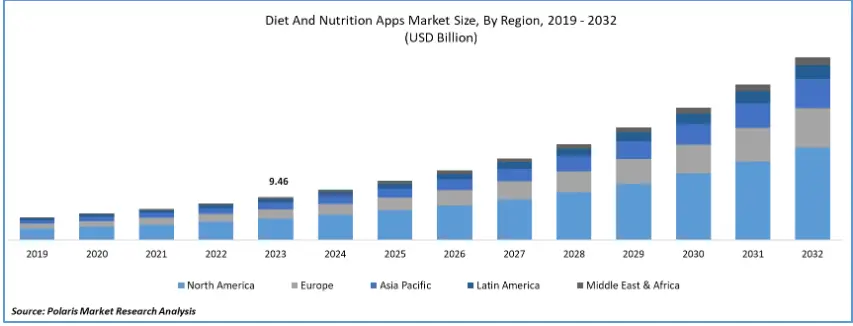
You see,, the market was already at $9.46 bn which will reach $11.09 bn by 2024 & $40.07 bn by 2032, depicting a growth rate of 17.4% yearly, showing signs that people are actually turning and using these food planner apps for their well-being to the fullest.
What other stats say:
- With over 200 million downloads globally these apps are clear signs that people are hungry for such apps.
- Nearly 45% of people report achieving weight loss goals by using these food planner apps, proving their effectiveness in reaching their aim.
- 30% of smartphone users globally have happily used these meal planner apps.
- People dedicate around 12 minutes every day to track their meals & monitor their progress through it.
With such a staggering number, who doesn’t want to hire mobile app developers and leverage the benefits of a growing market?
Let’s dig deeper, to know why meal planning apps are goldmines for users that are attracting businesses.
Why Develop a Meal Planning App?
The increasing number of downloads of these food planner apps depicts that they have several benefits that are attracting a lot of users.
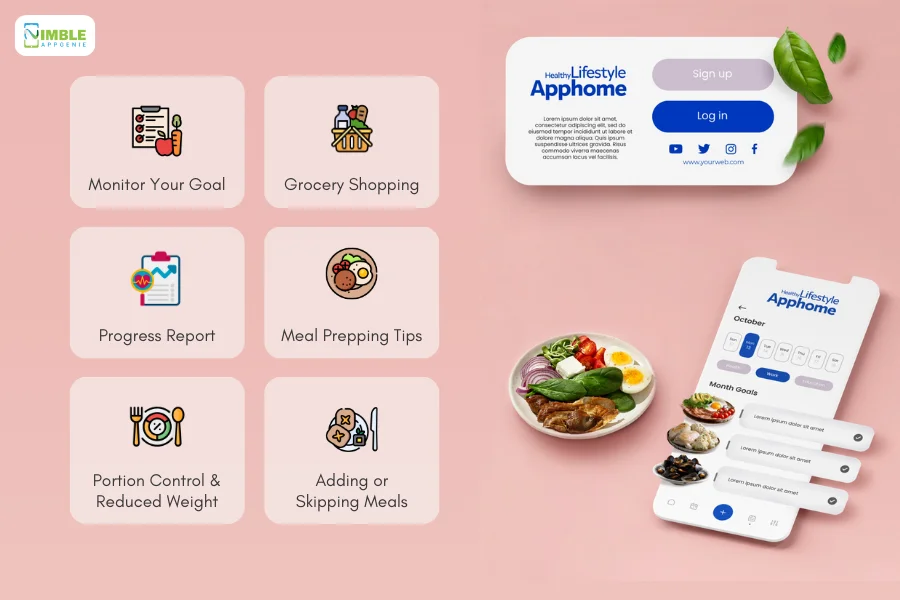
Below we are sharing some of them.
1. Monitor your Goals
Meal planning apps are filled with tools, so it’s easy to maintain, track, and make changes to your goals accordingly. Whether you want to lose weight, gain muscles, or live a healthy life, it’s stress-free to reach your goal with such an app by your side.
Other than that, meal planning apps coordinate your meal with the necessary ingredients, calories, and proteins so that you can enjoy a healthy lifestyle without missing any essential nutrients.
2. Grocery Shopping
Another top advantage of a meal planning app is providing lists of grocery shopping.
Whatever you plan to eat weekly or monthly, you can easily get a list of items needed. And with that, the app also informs you when your grocery list is updated. It will contain all the items that you need to make recipes on different days.
3. Progress Report
Showing graphs and stats helps users to know about areas of improvement and engages them with the app for a long time.
It’s a good way to understand whether you are going towards your goal or not and what changes you can make in your routine to be better. As a result, people like to use an app instead of writing down on a pen & paper.
4. Meal Prepping Tips
One reason people like to use these apps is they timely get tips that can improve their mealtimes.
Simply put, one of the biggest challenges that people often face is to come up with new ideas and find time to cook them.
With a meal-planning app, users can prepare and plan meals ahead for weeks. This can be a great solution to track all your food and ingredients.
5. Portion Control & Reduced Waste
Planning meals in advance allows you to pre-portion ingredients, and make sure you stick to healthy servings & limited portions.
This not only helps with managing weight but also eliminates food waste, and saves your effort, & money in the long run.
6. Adding or Skipping Meals
As you know unexpected things or changes happen in life.
The best part of food planner apps is their flexibility. If a last-minute lunch meeting or surprise dinner party throws your schedule off, then you can skip your planned meals with a single click and get back to the next plan accordingly.
We have seen the benefits of meal planning apps for users and why they love to use one. if you plan to create a food planner app, then what features can make your food planner app a massive hit?
Top Features That Can Determine the Success of Your Meal Planning Apps
If you want to develop meal-planning apps, you should integrate the best features. The market is dynamic but with these features, you can get a competitive edge.
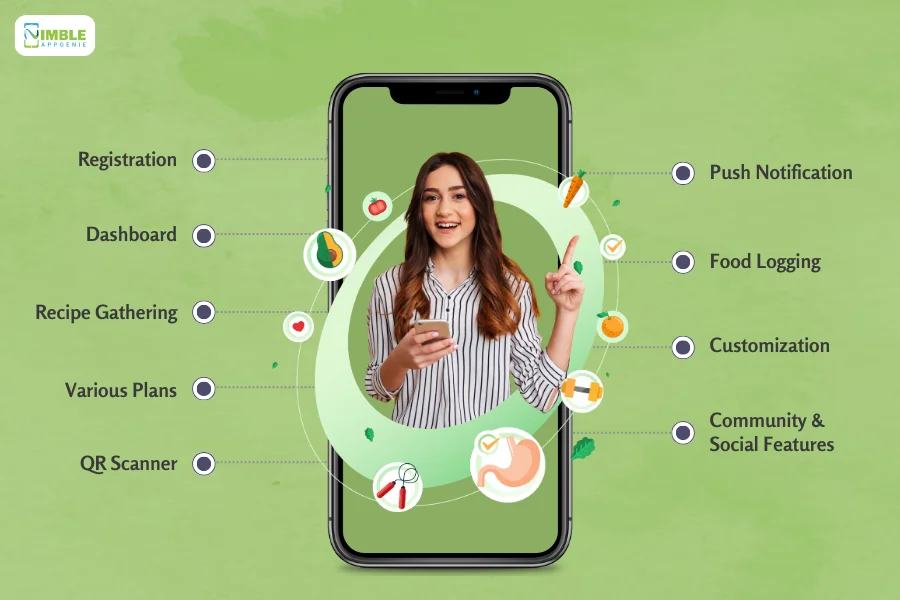
So, let’s get to know some of the must-have features for your meal-planning apps:
Registration
Easy Registration is a great feature to incorporate into your meal-planning app development. You can leverage the ongoing trend of social media integration to let them sign in through social apps easily and efficiently.
This can save a lot of time for the user and improve their experience with your app too. After all, no user wants to fill out long forms to get into the app. Additionally, you can integrate questionnaires too to understand their lifestyle and customize their plans.
Dashboard
It is necessary for you to create a food planner app with a dashboard feature as it offers a quick snapshot of multiple elements such as grocery lists, upcoming meals, order status, and more.
Since there are many elements on this screen, think of it as your personalized roadmap to a healthy week, all in one glance.
Recipe Gathering
It’s a must-have feature for a meal planning app which is necessary to organize your meal ahead. They offer a rich collection of features to store personal recipes, complete with descriptions and photos. Then build a library of delicious meals to easily add to your weekly plans.
Various Plans
It’s a great feature that means making your app useful to a broad category of people including Keto, Veganism, and others.
By offering a variety of plans, you can cater to all these types of people who have unique food choices. This personalized approach can help you to become a user-favorite in no time.
QR Scanner
A QR scanner is a must to incorporate in meal planners and calorie counter app development that allows users to scan the items of the product and get information about it.
Instead of manually typing, if they can just scan, it will help them to eat mindfully and make better decisions.
Push Notification
Utilizing push notification services for your meal planner app can be of great help. You can send your users timely feedback and progress graphs.
Other than that, it can also be utilized to target your customers with different deals or discounts that keep them hooked to your app.
Food Logging
When it comes to food logging, it’s a must-feature. Many fitness apps like MyFitnessPal also emphasized this.
This way one can record what you eat in a whole day, and compare your meals to your plans, find areas for change, and stay responsible on your health journey.
Customization
Customization is a great way to keep your users engaged.
Allow your users to personalize their app by changing their dietary preferences, servings, and favorite cuisines. This way you can offer multiple meal plans as per their choices.
Moreover, you can integrate with different fitness trackers to sync data and customize their recommendations.
Community & Social features
A sense of community can motivate a user to share their journey with others. Allow your users to create social groups on the app where they can share their recipes, get some tips, and as well as support too.
This will interest your users to be on healthy eating journeys with friends and family and discover meal plans from other users.
With this out of the way, let’s get to know about the cost to build a Meal planner app.
Cost to Build a Meal Planning App
So, how much does it cost to make a meal-planning app?
The Meal planning app development cost can range between $10,000-$30,000. This can increase or decrease as per project requirements or complexity.
The cost to make a fitness app or meal planner app depends on several elements that we will get to know in the below section. But, first, let’s see a quick breakdown of the meal planner app development cost.
| Basis | Cost | Description |
| Simple App | $10,000-$20,000 | Meal planning & Scheduling, Grocery list generation, user accounts & profiles |
| Mid-level App | $20,000-$40,000 | Customized recipe recommendations, Nutritional tracking & insights, Meal prep optimization |
| Advanced App | $40,000+ | Progress tracking & goal setting, integration with fitness tracker integration, and others. |
Important Note: it’s just an estimate of the cost to develop an app. To find out the actual cost to develop a meal-planning app like Food Planner, you need to understand specific needs and requirements that can be your overall cost.
For that, take a look at the section below.
Factors Affecting the Cost to Make a Meal Planning App
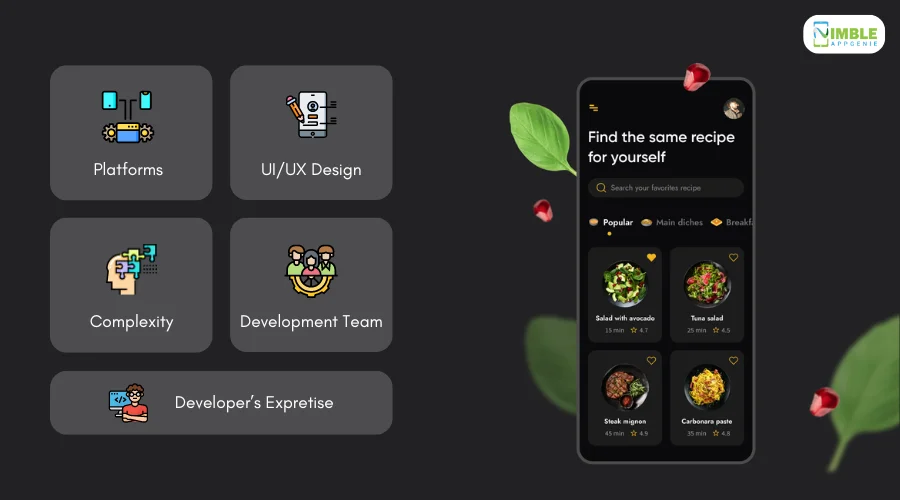
There are several factors that can affect the cost to build a meal-planning app, let’s get to know them one by one in detail:
1. Platforms
First is a “Platform”.
You will need to choose a platform to launch your meal planning app, for which you will get two choices one is Native, and the other one is Hybrid App Development.
Native App Development
- Android App Development– $20,000-$50,000
- iOS App Development– $20,000-$40,000
- Hybrid App Development– $10,000-$30,000
Native and hybrid both have their own benefits and disadvantages that we will discuss some other day. But overall, you should choose a platform as per your target audience, this will help you optimize your development costs.
2. UI/UX Design
If you are shaping your fitness app idea into a digital solution, make sure to do it in the best way possible. For which we will suggest to lay emphasis on UI/UX design.
Design can be basic layering for advanced animations, but do you know if your choice can impact your development cost?
Going for advanced designs initially might make a hole in your pocket without guaranteeing user satisfaction, whereas, a basic and minimalistic design can help to find all functions properly and enhance user experience.
3. Complexity
Another common factor that can affect your app development cost is your app idea. Complexity of your idea can lead to increasing costs to create a meal-planning app.
The more complex your project is, the more it will take developers time, effort, and your money. Just look at this table to understand through a quick breakdown:
| App Complexity | Estimated Development Cost | Factors influencing cost |
| Highly Complex App | $50,000+ | Advanced security features, multiple integrations, custom UI/UX designs, cross-platform compatibility, etc. |
| Average App | $30,000-$50,000 | Average features, third-party integration, comprehensive testing, etc. |
| Simple App | $10,000-$30,000 | Basic functions with simple UI/UX Design. |
4. Development Team
Without any doubt, to create a meal planner app, you need to find an app developer.
Searching for them and hiring them from a high-living standard country such as the USA and UK is more expensive than other countries.
To optimize your cost to develop the Meal Planning app, you can outsource development to regions with lower hourly rates.
For that, you need to have information about the hourly rates of countries. It’s given below take a look:
| Countries | Hourly rates |
| USA | $120-$150 |
| Australia | $100-$120 |
| UK | $80-$100 |
| Eastern Europe | $50-$80 |
| Asia | $25-$50 |
5. Developer Expertise
Another factor to consider is “Developer’s Expertise”.
If your developer has experience and expertise in their work, their charges won’t be nominal.
However, less experienced developers can offer lower rates but it can result in affecting your development speed and quality. So, the key is always to find expertise in your budget to ensure a successful project.
| Developer Expertise | Description | Hourly rate |
| Junior Developer | Have Basic Skills, but needs guidance. | $15-$35 |
| Mid-level Developer | Skillful in core functions. | $35-$75 |
| Senior Developer | Can lead teams, has expertise and experience to tackle the complexity of the project | $75-$150+ |
Now understand how many factors can affect your costs when developing a meal-planning app. To get a clearer picture, you can contact an experienced mobile app development company. With that, Let’s get to know how long it will take to develop such an app.
How Long Does it Take to Make a Meal Planning App?
Now, as we are done with that, time to understand “how long it takes to develop a meal planning app?”
On average, the development time can range from 17 weeks to 25 weeks. However, there are several factors that come into play to decide development time, and unsurprisingly all those factors affect the development cost.
Let’s take a quick look at the development time:
| Basis | Time Taken |
| Conceptualization | 1-2 weeks |
| App Designing | 2-4 weeks |
| App Development | 8-12 weeks |
| Testing and QA | 4-6 weeks |
| Launch | 1-2 weeks |
| Maintenance | Ongoing |
Now, after clearing all the major points, now remains only one question that after developing such an app, how will you earn revenue from a meal planner app, that brings us to our next section.
Monetization Models to Utilize in Your Meal Planning App
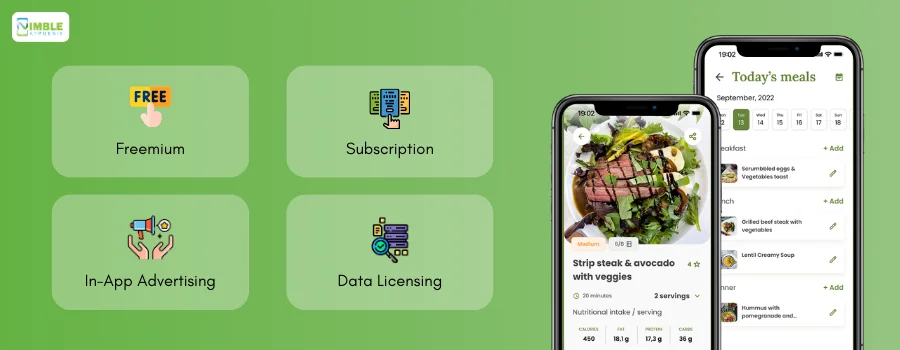
So, why does any investor build an app? To earn revenue. Right?
To ensure that you earn a substantial income and recover your costs, develop a meal-planning app, learn and integrate some of the best monetization strategies for your app.
► Freemium
A well-known monetization model “ Freemium”.
You can offer basic features for free and then ask for a fee from users to access your app’s premium features. This way they can understand what your app has to offer and can pay to enjoy the app better. Make sure to integrate some best features that make users pay such as advanced filtering, tracking, stats, ad-free experience, and more.
► Subscription
With so many subscription-based apps around you, it’s undoubtedly not a new concept, but instead a tried and tested one.
Through this, you can offer a variety of features such as exclusive recipe collection, ongoing coaching, and more at a fee. This model works well when you have ongoing value to offer to your users.
► In-app advertising
Another top monetization model is “In-app Advertising”.
As the name implies, you can show ads of different types to your users such as banner ads, video ads, and more. This way, without paying a single penny your user can enjoy the app and you can also earn.
► Data Licensing
Meal planner apps collect huge data including dietary habits, preferences, etc. You can sell these to different companies, health organizations, and others for a fee.
This way you can open additional sources of revenue from users. Make sure to get permission from users or have it written in your terms and conditions.
How Nimble AppGenie Can Help You Build a Meal Planning App?
Do you want to develop a meal-planning app?
Experts at Nimble AppGenie, the best fitness app development company, are ready to provide you with their expertise and experience to build a successful meal planning app.
Acknowledged by many top platforms such as Design Rush, GoodFirms, and Clutch. co, we have the right tools & experience for your project needs.
If you have an idea, contact us to make it a successful reality.
Conclusion
In essence, the meal planner app market is thriving, and developing one can be a profitable venture. The cost of building a meal-planning app depends on features and complexity.
Consider factors like platform, development team location, and developer expertise when budgeting. By incorporating the right features and monetization strategies, you can create a successful food planner app that helps users reach their health goals.
FAQs
A food planning app is a software application that helps you plan and prepare meals. It can help you save time and money, reduce food waste, and stick to a healthy diet.
Here are some popular benefits:
- Helps you reach your goals (weight loss, muscle gain, healthy eating)
- Saves time and money on groceries
- Reduces food waste
- Provides recipe inspiration
- Creates grocery lists
- Track your food intake and progress
The cost to develop a meal-planning app can range from $10,000 to $50,000 or more. The final cost depends on several factors, including features, complexity, platform (Android, iOS, or both), and developer location.
On average, it can take between 17 and 25 weeks to develop a meal-planning app, depending on the complexity of the features.
There are several ways to monetize your meal-planning app, including:
- Freemium model: Offer basic features for free and charge for premium features.
- Subscription model: Offer all features for a monthly or yearly subscription fee.
- In-app advertising: Display ads within the app.
- Data licensing: Sell anonymized user data to companies or research institutions.

Niketan Sharma is the CTO of Nimble AppGenie, a prominent website and mobile app development company in the USA that is delivering excellence with a commitment to boosting business growth & maximizing customer satisfaction. He is a highly motivated individual who helps SMEs and startups grow in this dynamic market with the latest technology and innovation.
Table of Contents




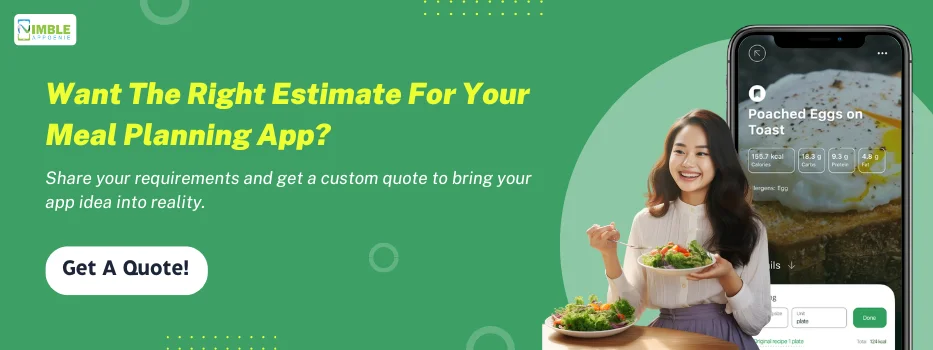








No Comments
Comments are closed.